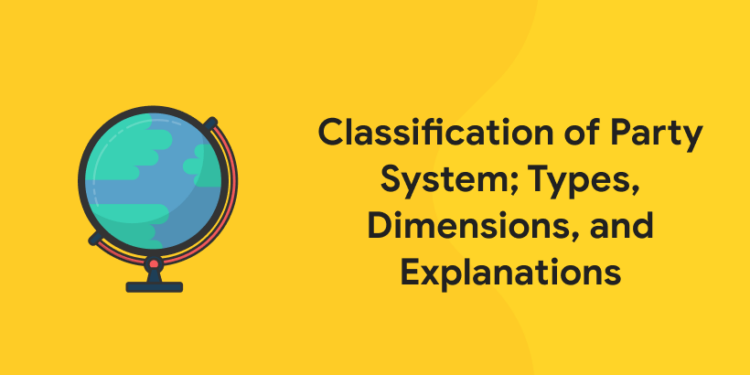Table of Contents
A party system is a idea in comparative political science regarding the system of presidency by political events in a democratic country. The concept is that political events have simple similarities they manipulate the government, have a strong base of mass famous support, and create inner mechanisms for controlling funding, statistics and nominations.
Political scientists have prominent among unique varieties of political events which have developed at some stage in history. These encompass cadre events, mass events, catch-all events and cartel events.
Attempt Free GK Mock test ! Download Entri App!
Classification of Party System
The Elitist Parties
The elitist parties are normally divided into (a) the European Type and (b) the American Type.
The European type:
Most of the political parties set up in the nineteenth century are elitist in nature. Many contemporary parties who follow the same approach also come in the elitist or traditional category. Whether these parties are liberal or conservative or progressive, they are against admitting anybody and everybody to their membership. These parties emphasise quality rather than numbers. They seek support of prominent and influential persons.
The American Type:
The parties in the United States are different from British parties in several respects. But, the prominent differences are (i) the nature of presidential government in a federal set-up, as against British parliamentary democracy in a unitary state and (ii) the U.S. parties have remained limited to the elite, away from the masses. The U.S. parties, as mentioned elsewhere, are essentially
election-oriented. The system of party primaries was introduced in the early twentieth
century.
Mass Parties
British Labour Party had its origin in the working people’s movement. Some of the parties of
European countries, like the Christian Democratic Parties and the Popular Republican
Movement (P.R.M.) of France may also be placed in the category of mass parties.
Socialist Parties:
Initially, masses were contacted to donate funds for the labour candidates. These candidates were considered revolutionaries, and industrialists and big business houses declined to give them any financial contribution. In fact these elements were quite opposed to these candidates. In Britain trade unions provided support to these candidates.
The British Labour Party was described as the pioneer of the socialist parties the world over. Democratic socialist parties in several countries followed the British Labour Party. These parties believe in socialism to be brought about by the peaceful democratic means of parliamentary process.
The Communist parties:
The communist parties based on the ideology of Marx and Lenin seek close contacts with the masses. Initially, European communist parties were organised on the pattern of socialist parties, but after 1924, they were reorganised on the directions of Communist International headquartered in Moscow. They followed the pattern of Soviet Communist Party. The communist parties everywhere
are much better organised and disciplined as compared to other parties.
Communist parties follow the principle of ‘democratic Centralism’, which implies democratic
participation of members in party structure, but centralised decision making and supervision.
The Fascist Parties:
Fascism is totally opposed to communism. Unlike the communist parties, fascists advocate an all-powerful state. However, there is one similarity. Both believe in one-party rule, and in destroying the entire opposition. They both use force to implement their policies. The fascist parties support open
competition and capitalism, but they, like the communists, blindly follow one leader.
Fascism comes to power with the support of capitalists and big business houses. It is vehemently opposed to communism, and destructive of democracy. Violence and wars have been important part of fascist programme.
Grab Study Materials to Strengthen your Knowledge in GK!! Register Here!
Intermediate Type Parties
The is a third category of political parties that may be described as the intermediate type. These are different from both elitist and mass parties.
Indirect Parties:
At times a number of big or small committees perform political functions leading to the setting up of a political party. This may be described as an indirect party. It began functioning with the association of trade unions, cooperative societies, the Fabian Society and other intellectual bodies. These bodies selected candidates for election, collected funds and carried out their election campaign.
Parties in Developing Countries:
In the post-Second World War period a large number of political parties have come into existence in the third world developing countries, which Duverger prefers to describe as undeveloped countries.
In some of the developing countries, the parties followed the pattern of the United Kingdom or
the United States, while in some others one party was established following the Soviet example. In some of the African countries two parties each were formed in their own style. All of them have been described as intermediate type because they were yet to be fully organised as disciplined parties.
Attempt Free GK Mock test ! Download Entri App!
Types of Party System
Party systems are mainly classified as,
- One-party system: Only one party is allowed to control and run the government. Usually based on the existing constitution, or where only one party has the exclusive control over political power. For example, in China, only the Communist Party is allowed to rule.
- Two-party system: Only the two main parties have a serious chance of winning a majority of seats to form a government. Typically placed either side of the center, have a realistic chance of forming a majority. Other parties are very minor or solely regional. The United States of America and the United Kingdom are examples of a two-party system.
- Multi-party system: More than two parties have a reasonable chance of coming to power either on their own strength or in alliance with others. Thus in India, we have a multiparty system. So example: India.
- Dominant-party system: a system where there is “a category of parties/political organizations that have successively won election victories and whose future defeat cannot be envisaged or is unlikely for the foreseeable future”.
- Non-partisan system: a system of government or organization such that universal and periodic elections take place without reference to political parties.
One-Party System
One-party system implies the existence of only one party in a country. The countries committed to certain ideologies such as Marxism or Fascism normally do not allow the existence of any opposition party. In one-party states, there is, therefore, no opposition. Parties other than the ruling party are either constitutionally debarred, or they are crushed by the rulers. This system originated with the establishment of the rule of the Communist Party of the USSR after the Bolshevik Revolution. While the critics deplored the system as authoritarian rule of the Communist Party, the USSR claimed it to be the rule of the working classes.
The term one-party system was initially used after 1930 by certain Fascist writers. Prominent among them were Manoilesco and Marcel Deat. They tried to find similarity between Fascist/Nazi and Communist regimes.
Attempt Free GK Mock test ! Download Entri App!
Two-Party Systems
In modern democracies, there are two or more competitive parties. There are, obviously, at least two parties. None of these is more stable or powerful than the other on a permanent basis. If, however, one party remains in power for a very long period of time and the other continues to occupy opposition benches then it becomes a dominant party system; it ceases to be a competitive two-party system. The leaders and scholars of the United Kingdom and the United States consider ‘dualism’ as the best system.
In the two-party system, there is constant competition between the two parties for securing majority of popular votes and seats in the legislature. Both the parties keep on occupying either the treasury benches or sit in the opposition, though this may not always be alternate. Besides, there may be one or more smaller parties also in the two-party system.
The American two-party system
The United States has always had a two-party system, first in the opposition between the Federalists and the Anti-Federalists and then in the competition between the Republicans and the Democrats. There have been frequent third-party movements in the history of the country, but they have always failed. Presidential elections seem to have played an important role in the formation of this type of two-party system.
The British two-party system
Another form of the two-party system is operative in Great Britain and in New Zealand. The situation in Australia is affected somewhat by the presence of a third party, the Nationals (formerly the Australian Country Party). A tight alliance between the Nationals and the National Party of Australia introduces, however, a rather rigid bipolarization with the Labour Party.
Multi-Party Systems
There are several countries that have developed a system of having many parties. Technically, the existence of three or more big parties may be described as multi-party system. India has over 40 political parties, big or small, represented in the Lok Sabha. In a multi-party system, three, four or more parties may get together at any point of time to form coalition governments. Such governments generally adopt a common minimum programme for governance, as they do not have commitment to any one ideology.
Attempt Free GK Mock test ! Download Entri App!
Download Entri App, Entri provides you effective learnings in a period of time with the help of expert teams and you can accomplish the goal with the Entri App. Start your preparation for your dream government job with Entri App. We provide a wide range of courses over different government exams. We are providing you the best platform for the preparations for every prestigious exam. Here you can get access to a number of mock tests and get daily practice GK and Current affairs questions.
For candidates preparing for competitive exams like Bank Exam, UPSC exam and other Government Exams. Static GK connotes general knowledge about the static facts, the facts that are never going to change in the future. Entri App provides you with the best knowledge in GK and coaches candidates on different exams in your local language.













